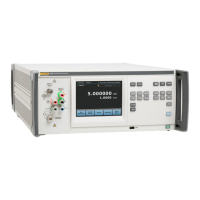A-1
Appendix A
Glossary of AC-DC Transfer Related
Terms
Absolute Uncertainty
Uncertainty that includes contributions from all sources, for example, traceability
to national standards of the standards used, plus the uncertainty of the
measurement process. Absolute uncertainty should be used to compute test
uncertainty ratio. Also see “relative uncertainty”.
Accuracy
The degree to which the measured value of a quantity agrees with the accepted,
consensus, or true value of that quantity. Accuracy is the same as 1 - %
uncertainty. For example, an instrument specified to ±1 % uncertainty is 99 %
accurate. Also see “uncertainty”.
Artifact Calibration
An instrument calibration technique that uses a calibration system within the
instrument to reduce the number of required external standards to a small
number of artifact standards. The Fluke 5730A Calibrator uses Artifact
Calibration.
Artifact Standard
A stable object that produces or embodies a physical quantity for use as a
reference standard. An artifact standard may have an assigned traceable value
when used for calibration purposes. Fluke 732A DC Voltage Reference Standard
and the Fluke 742A Series Standard Resistors are examples. Also see “transfer
standard”.
AC-DC Absolute Uncertainty
Includes all known error sources contributing to the uncertainty of an AC-DC
difference correction. This includes NIST (National Institute of Standards and
Technology) uncertainties, transfer uncertainty from a primary standard to
working standard, and internal error contributions (both random and temperature
related).

